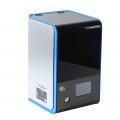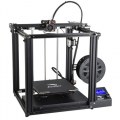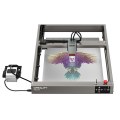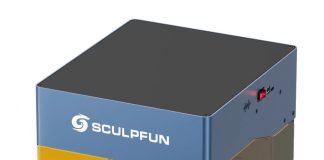Creality Ender-5 Pro
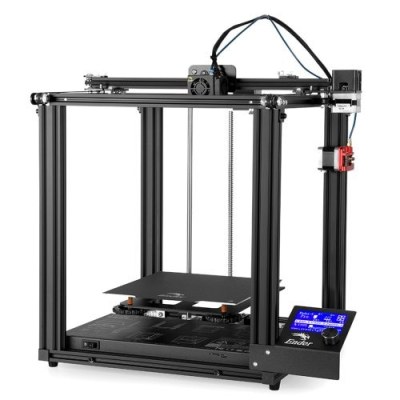
-
1: 220 x 220 x 300mm Print Size
-
2: Silent Mainboard
-
3: Removable Platform
-
4: Dual Y-Axis
-
5: Modular Design
Creality Ender 5 Pro Upgraded 3D Printer
One of the most popular and probably best-selling 3D printers from China was the Ender 3 (Pro), which was able to convince with great results at a low price and was therefore probably sold more than 100,000 times (according to Creality).
The Ender 5 Plus is clearly yours, which is also reflected in the technology used. Unfortunately, despite the high price, the technology of the Ender 5 Pro was not used, so that you do not get the silent board, the metal extruder or the Capricon Bowden tube. The pressure room grows to a gigantic 350 x 350 x 400 millimeters and a touch display and BLTouch sensors that facilitate leveling have been installed. Another innovation is the filament sensor, which detects when the filament is used up and pauses printing automatically. The large print bed on the Z-axis is no longer supported by two, but by four guide rodsworn and there is also a second motor, so that the bed is driven on both sides. With the Ender 5 Plus, all components, including the filament, are housed within the metal frame, but with dimensions of 632 x 666 x 619 millimeters, there is also enough space there.
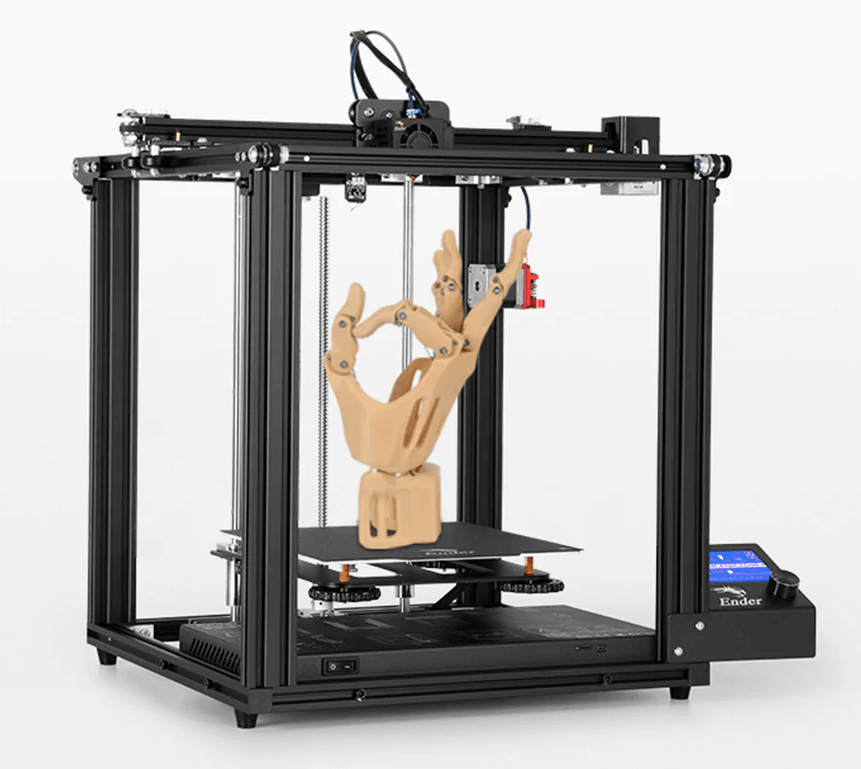
Setting it up couldn’t be easier. You only have to screw the base with four columns and the upper part, attach the scaffold for the Z axis and mount the display. The instructions for this are printed out, printed on the enclosed microSD card and even on the housing of the printer. The printer can be set up in under an hour, even for laypersons. If you hurry, you can do it in half. Since all toothed belts are already tensioned and adjusted, you only have to connect the cables after assembly, level the print bed and off you go.
The Ender 5 series is constructed differently than all other filament 3D printers that we have tested so far. It is common for the print bed to move on the Y axis and the hot end to move on the X and Z axes. The Ender 5 Pro, however, is a portal design printer. This means that the print bed moves down on the Z axis, while the hot end is guided on the X and Y axes on the upper frame of the printer.
A disadvantage is that the print bed is only stabilized on one side by two guide rails and a threaded rod , but bends minimally downwards on the other side under high loads. However, I was never able to determine any impairment in pressure. The Y-axis runs on two rails on the left and right and is driven by a motor, the shaft of which runs through the motor as a whole ( Double Y-Axis ) and has a toothed belt on each side in order to generate as little unwanted movement as possible. The X-axis runs back and forth on the movable Y-axis. Which concept appeals to you more is a matter of taste. I couldn’t find any real advantages or disadvantages, except that you have more space when leveling the portal printer, because the printing plate is at the top, directly at the hot end during this process.
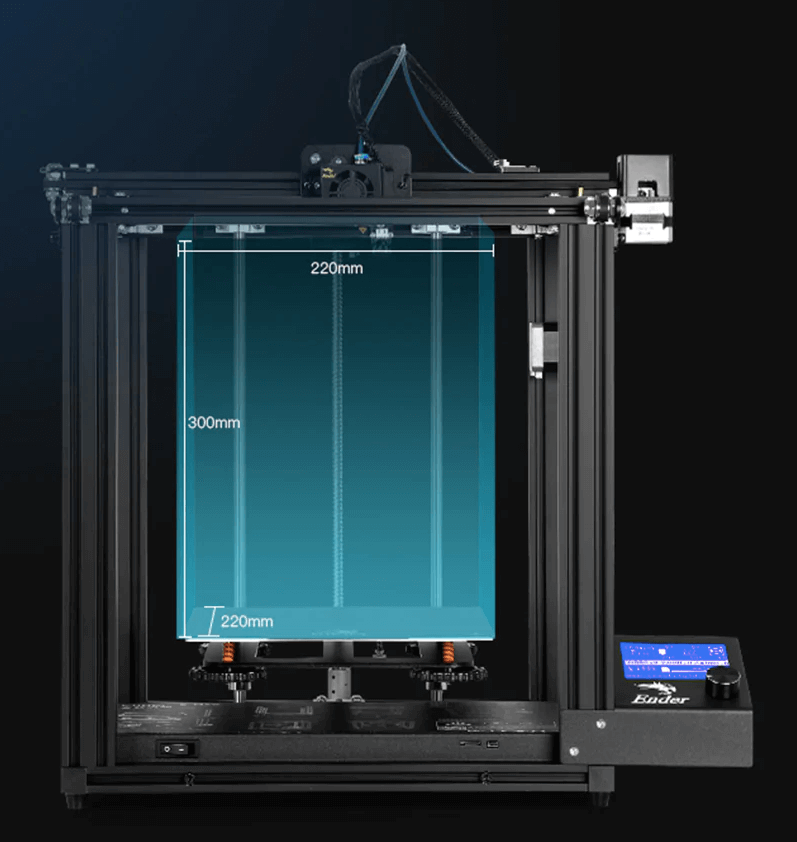
The printing area of the Ender 5 Pro measures 220 x 220 x 300 millimeters , and the entire printer measures 552 x 485 x 510 millimeters plus the filament holder that protrudes from the cube on the right side. The entire device consists of four-square aluminum profiles and is very stable and torsion-resistant. The heating plate can be heated up to 110 °C. The supplied print bed consists of a rather thin, flexible magnetic mat that holds on the heating plate without any other attachment.
The display is a single-color, blue LC display without further details. I guess 128 × 64 pixels. This is absolutely sufficient for the printer and control via a single rotary control with a print function for confirmation is very simple. The only flaw I could notice is the lack of cover on the back of the display, where the board is just exposed. Not only did I seem to have noticed the problem – there are already files on Thingiverse to print a housing for the display itself.
All ports and switches are positioned on the front and easy to reach. There we find the power button, a port for micro SD cards and a mini USB connection. Inside the Ender 5 Pro, the new V1.15 silent mainboard from Creality3D works with TMC2208 motor drivers. On the one hand, this hardware is trimmed to a particularly low volume when printing, on the other hand, it is also designed for particularly high and precise performance. The motors can reach a printing speed of up to 180mm/s (40-80mm/s are recommended) and the hotend can be heated up to 260 °C. The accuracy is specified with only 0.1mm. Compared to the Alfawise U30 Pro, which is specified as 0.0125mm, the pressure is much better. So I assume that Creality3D was just very careful here.
In addition to some test files, the virus-free micro SD card also contains the in-house Crealtiy Slicer. The program is based on the Open Source Engine Cura, and offers almost the same functions that you get with the original Cura from Ultimaker. I personally find the latter more modern and easier to use. There is also an already configured profile for the Ender 5, so it makes sense to use the original Cura. The Gcode that the slicer spits out can then be easily selected and printed from the SD card using the clear menu on the printer.
The printer itself runs with the Marlin open source software version 1.1.8 and Crelity 3D has kindly directly unlocked a boot loader to allow experts to use a different firmware. In addition to the standard functions, the Ender 5 Pro can remember its current position when the power is interrupted and continue there when the power is back. There is also overheating protection, which luckily I could never try.
After I was last allowed to test the Alfawise U30 Pro with color touch display, I was initially skeptical of the printer’s TFT display. But with the combination of a control dial and push button, the printer is very easy to control. Press to confirm and turn to choose between the different menu options or adjust parameters.
The printer can then be leveled via the display, but not as easily as we know from other printers. You can only move to the zero point , then you have to deactivate the stepper motors and manually move the hotend to the various positions, where you can then adjust the height of the printing table. Furthermore, the filament can be changed via the display, the individual motors can be controlled and Gcode files can be called up from the SD card. During printing, you can change all parameters such as flow rate, speed and temperature, and pause or pause the pressure. You can also see the percentage of printing progress and the time that has passed since printing started.
The motors are super quiet in operation, only the fan provides some volume. This once stopped in our test device and started to whistle. After a short nudge, everything was fine again and there were no problems during the entire test period. Creality3D uses the same motor drivers as Alfawise in the U30 Pro, but you notice the Silent Board here – the Ender 5 Pro is significantly quieter in operation than the product from Gearbest.
With the Ender 5 Pro, the printing table is only attached to two metal guides on one side . At first this gives the impression that the construction is too unstable, but I never had any problems with it during operation. Anyone who is worried that the lack of support could affect print quality is better off using the Ender 5 Plus, which has guide rails on both sides.
From the price, which is in the upper range for a device from China, you can see that Creality’s demands on the device are high. Even the Ender 3 was able to convince with first-class performance and the Ender 5 puts it a step further. The sample files are printed in 0.1mm layer thickness and leave little room for criticism. The structure is somewhat uneven on strong overhangs, but as soon as it goes straight up, the pressure is flawless. You have to adjust your own files or models from the network in the slicer, of course. As with any printer, it takes a few tries to find the perfect settings, but it gets better with every print. Changes that I made, for example, were to increase the flow rate a bit because I had to struggle with under-extrusion at times. I had already mentioned warping (peeling off the first layer), the solution for this was the hairspray.
The Creality3D Ender 5 can be ordered for currently $360. For this you get a printer that is really impressive. The menu navigation is simple but well thought out. The components used are of good quality, the scope of delivery is exemplary and the printing results can delight. An auto-leveling and stand-by function would have been nice and the electronics of the display could have been blended. Otherwise there are no criticisms, especially since there is a large community around Creality, which is constantly developing improvements and helping with problems. On our part, there is clearly a recommendation for the Ender 5 Pro. In the mass of Chinese models, it is difficult to recommend an alternative. Of course, the Alfawise U30 Pro or the CR-10 Mini, which we both already had in the test, is much cheaper. Logically, the cheaper price is also reflected in the print quality.
SPECS
Product Details
| Features |
Intelligent 3D space sturdy cubic structure Double performance in a single machine Removable platform for better printing Ingeniously designed for geeks Modular design DIY fun Independent developed ultra-mute motherboard gives fewer noises and higher precision Metal extruding unit stable feeding and wear-resisting Double Y-axis, stable output High-standard v-slot profile for stable printing Strict controls on details and quality |
| Specification |
Brand: Creality Model: Ender-5 Pro Type: DIY Material (Frames): Aluminium Extrusion Platform board: Aluminum Base Nozzle quantity: Single Nozzle diameter: 0.4mm Product forming size: 220*220*300mm Layer thickness: 0.1-0.4mm Memory card offline print: TF card Print speed: Recommend 60mm / s Supporting material: ABS,PLA Material diameter: 1.75mm Language: Chinese,English File format: AMF,OBJ,STL Model supporting function: Yes Voltage: 110-240V Working Power: rated voltage 115v / 230v, output 24v Host computer software: Cura,Repetier-Host,Simplify3D Packing Type: Assembled packing System support: Win XP / Vista / 7/10 / Mac / Linux Connector Type: TF card,USB |
REVIEWS
Disclaimer Note
Ratings are based on objective reviews from our users.


